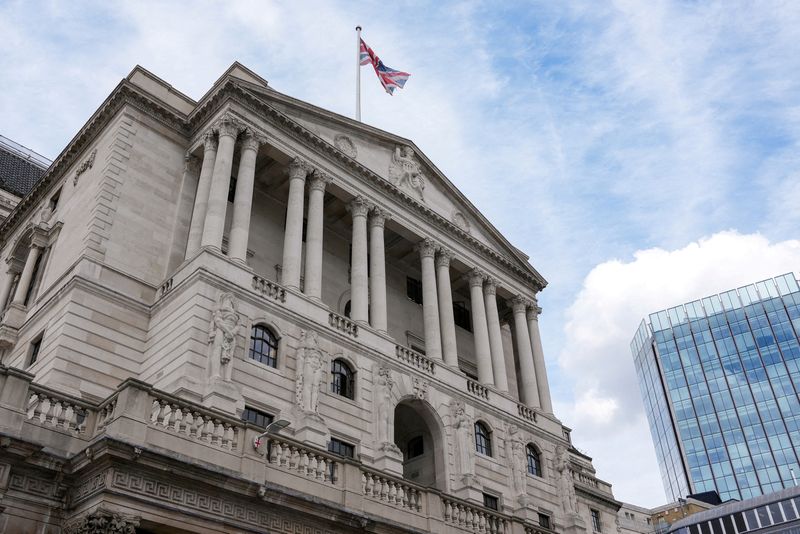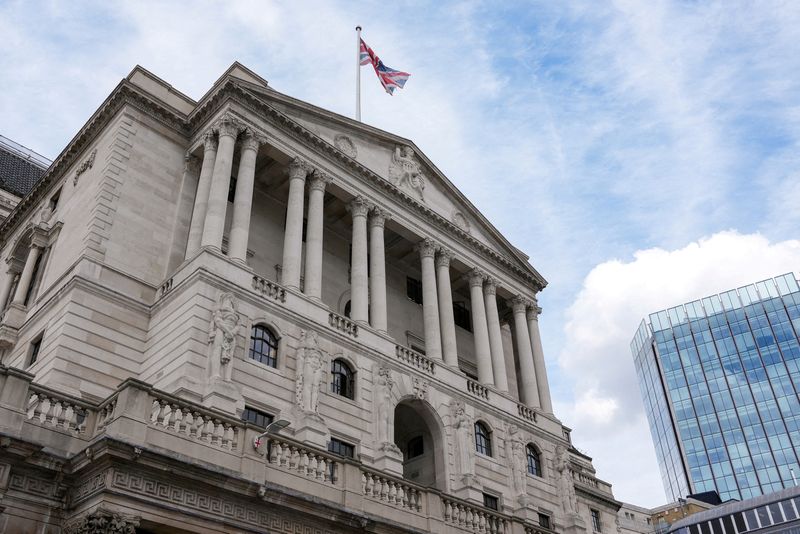Economy
Bank of England readies what may be its final rate hike


© Reuters. FILE PHOTO: A general view of the Bank of England (BoE) building, the BoE confirmed to raise interest rates to 1.75%, in London, Britain, August 4, 2022. REUTERS/Maja Smiejkowska//File Photo
By Andy Bruce
LONDON (Reuters) – The Bank of England is likely to hike interest rates once again this week, possibly the last hurrah for one of the great tightening cycles of the last 100 years as a cooling economy begins to worry policymakers.
All but one of 65 economists polled by Reuters in recent days predicted the BoE will raise Bank Rate to 5.5% on Thursday from 5.25%, which would mark its highest level since 2007.
Financial markets are less certain than economists – with rate futures on Friday showing a 25% chance of a pause – but both are coming to the view that the streak of rises in borrowing costs since December 2021 is in its last days.
If Bank Rate does peak at 5.5% – from a starting point of 0.1% – it would rank fourth on the list of Britain’s biggest tightening cycles of the last century, behind surges that took place in the late 1980s and in the early- and late-1970s.
Recession accompanied all of those prior sharp increases in rates – and a downturn is increasingly on the minds of the Monetary Policy Committee (MPC), with the 14 rate hikes it has already made yet to fully feed through into the real economy.
Much of the data over the last week underlined Governor Andrew Bailey’s comment this month that the BoE was “much nearer” to ending its tightening cycle.
Economic output in July dropped more steeply than expected, even if one-off factors like strikes were behind some of the fall, and the unemployment rate has already overshot the BoE’s forecast for the third quarter as a whole.
The European Central Bank also cited a weak economic outlook when it hiked rates last week and signalled that would be its last such move in the current cycle.
But with inflation in Britain still running higher than in any other major advanced economy, the calculation for BoE officials is arguably more complex – with hot wage growth data in Britain still pointing to inflationary risks.
“While we expect the critical mass of the committee to be grouped around a 25 basis-point hike, the uncertain, finely balanced nature of the turning point in the cycle means we believe there will be dissenters on both sides,” said Jack Meaning, chief UK economist of Barclays.
Data between now and Thursday’s announcement could yet change the debate.
Inflation figures for August due on Wednesday are likely to buck the falling trend thanks to rising petrol prices.
Investors will be wary of the BoE’s tendency under Bailey to react strongly to above-forecast inflation prints – an approach that some economists say has undermined its ability to deliver a consistent message and control market rates.
As ever, the language employed by the MPC on the path ahead, and shifts the balance of opinion, could have a big market impact.
Benjamin Nabarro, chief UK economist at Citi, said a speech last week from the MPC’s most hawkish member Catherine Mann – in which she warned against a pause for interest rates – might offer an early clue.
“Mann’s explicit pushback against a pause, and linked rebuke of majority MPC judgements is, we think a sign of an internal discussion that is moving against her. A pause therefore is, we think, part of the discussion.”
Economy
Russian central bank says it needs months to make sure CPI falling before rate cuts -RBC


© Reuters. Russian Central Bank Governor Elvira Nabiullina attends a news conference in Moscow, Russia June 14, 2019. REUTERS/Shamil Zhumatov/File Photo
MOSCOW (Reuters) – Russia’s central bank will need two to three months to make sure that inflation is steadily declining before taking any decision on interest rate cuts, the bank’s governor Elvira Nabiullina told RBC media on Sunday.
The central bank raised its key interest rate by 100 basis points to 16% earlier in December, hiking for the fifth consecutive meeting in response to stubborn inflation, and suggested that its tightening cycle was nearly over.
Nabiullina said it was not yet clear when exactly the regulator would start cutting rates, however.
“We really need to make sure that inflation is steadily decreasing, that these are not one-off factors that can affect the rate of price growth in a particular month,” she said.
Nabiullina said the bank was taking into account a wide range of indicators but primarily those that “characterize the stability of inflation”.
“This will take two or three months or more – it depends on how much the wide range of indicators that characterize sustainable inflation declines,” she said.
The bank will next convene to set its benchmark rate on Feb. 16.
The governor also said the bank should have started monetary policy tightening earlier than in July, when it embarked on the rate-hiking cycle.
Economy
China identifies second set of projects in $140 billion spending plan


© Reuters. FILE PHOTO: Workers walk past an under-construction area with completed office towers in the background, in Shenzhen’s Qianhai new district, Guangdong province, China August 25, 2023. REUTERS/David Kirton/File Photo
SHANGHAI (Reuters) – China’s top planning body said on Saturday it had identified a second batch of public investment projects, including flood control and disaster relief programmes, under a bond issuance and investment plan announced in October to boost the economy.
With the latest tranche, China has now earmarked more than 800 billion yuan of its 1 trillion yuan ($140 billion) in additional government bond issuance in the fourth quarter, as it focuses on fiscal steps to shore up the flagging economy.
The National Development and Reform Commission (NDRC) said in a statement on Saturday it had identified 9,600 projects with planned investment of more than 560 billion yuan.
China’s economy, the world’s second largest, is struggling to regain its footing post-COVID-19 as policymakers grapple with tepid consumer demand, weak exports, falling foreign investment and a deepening real estate crisis.
The 1 trillion yuan in additional bond issuance will widen China’s 2023 budget deficit ratio to around 3.8 percent from 3 percent, the state-run Xinhua news agency has said.
“Construction of the projects will improve China’s flood control system, emergency response mechanism and disaster relief capabilities, and better protect people’s lives and property, so it is very significant,” the NDRC said.
The agency said it will coordinate with other government bodies to make sure that funds are allocated speedily for investment and that high standards of quality are maintained in project construction.
($1 = 7.1315 renminbi)
Economy
Russian central bank says it needs months to make sure CPI falling before rate cuts -RBC


© Reuters. Russian Central Bank Governor Elvira Nabiullina attends a news conference in Moscow, Russia June 14, 2019. REUTERS/Shamil Zhumatov/File Photo
MOSCOW (Reuters) – Russia’s central bank will need two to three months to make sure that inflation is steadily declining before taking any decision on interest rate cuts, the bank’s governor Elvira Nabiullina told RBC media on Sunday.
The central bank raised its key interest rate by 100 basis points to 16% earlier in December, hiking for the fifth consecutive meeting in response to stubborn inflation, and suggested that its tightening cycle was nearly over.
Nabiullina said it was not yet clear when exactly the regulator would start cutting rates, however.
“We really need to make sure that inflation is steadily decreasing, that these are not one-off factors that can affect the rate of price growth in a particular month,” she said.
Nabiullina said the bank was taking into account a wide range of indicators but primarily those that “characterize the stability of inflation”.
“This will take two or three months or more – it depends on how much the wide range of indicators that characterize sustainable inflation declines,” she said.
The bank will next convene to set its benchmark rate on Feb. 16.
The governor also said the bank should have started monetary policy tightening earlier than in July, when it embarked on the rate-hiking cycle.

 Forex3 years ago
Forex3 years agoForex Today: the dollar is gaining strength amid gloomy sentiment at the start of the Fed’s week

 Forex3 years ago
Forex3 years agoUnbiased review of Pocket Option broker

 Forex3 years ago
Forex3 years agoDollar to pound sterling exchange rate today: Pound plummeted to its lowest since 1985

 Forex3 years ago
Forex3 years agoHow is the Australian dollar doing today?

 Cryptocurrency3 years ago
Cryptocurrency3 years agoWhat happened in the crypto market – current events today

 World3 years ago
World3 years agoWhy are modern video games an art form?

 Commodities3 years ago
Commodities3 years agoCopper continues to fall in price on expectations of lower demand in China

 Economy3 years ago
Economy3 years agoCrude oil tankers double in price due to EU anti-Russian sanctions

























